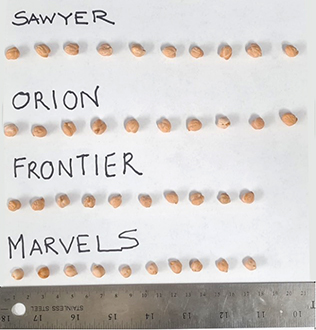Culinary and nutritional qualities of selected pulse crops from Montana and Washington
Authors: Edwin Allan, Sumedha Garg, Wan-Yuan Kuo
Contact [email protected] for questions or to request more information.
Introduction
Montana pulse crops are typically priced lower compared to other states such as WA1,2. This study assessed culinary and nutritional qualities of MT-grown lentils and chickpeas to support their market value.
|
Crop
|
Variety
|
MT
|
WA
|
|---|---|---|---|
|
Lentil
|
Pardina
|
1
|
2
|
|
Lentil
|
French Green
|
1
|
-
|
|
Lentil
|
Richlea
|
1
|
-
|
|
Chickpea
|
Sierra
|
1
|
2
|
|
Chickpea
|
Orion
|
1
|
-
|
|
Chickpea
|
Frontier
|
1
|
-
|
|
Chickpea
|
Marvel
|
1
|
-
|
|
Chickpea
|
Sawyer
|
1
|
-
|
Culinary tests
Lentils were soaked for 0, 3, 12, and 24hrs. Chickpeas were soaked for 8, 10, 12, and 24hrs. Lentils (3-hr soak) and chickpeas (10-hr soak) were cooked, seasoned with vinaigrette, and evaluated by 68 consumers using a 9-point hedonic scale for overall acceptance and Check-All-That-Apply (CATA) to identify terms that resonated with the samples. Texture of cooked seeds was measured by a texture analyzer (TA-XTplus, Texture Technologies Corp., Hamilton, MA).
Nutritional tests
Total starch (TS) and protein were measured using Megazyme test kit and near infrared analysis, respectively.
Findings
Culinary Properties
Lentils
3-hour soaking: best flavor and mouthfeel after cooking (15 min), compared to no soak or longer soak.
MT Pardina absorb less water than WA Pardina (may be due to harder seed coat from lower humidity in MT).
Sensory tests on Pardinas and French Green: Consumer acceptance ranged from 5.8 to 6.2, with no varietal or regional differences. More favorable lentils tend to bear sweet and cooked pea flavors, cooked pea aftertaste, tightly attached skin, and less aftertaste of raw pea.
Chickpeas

10-hour soaking: best flavor and mouthfeel after cooking.
Orion & Sawyer (larger seeds) cook faster (15 minutes) and have a harder texture, compared to Frontier & Marvel (smaller seeds) cook slower (19 minutes) and have a softer texture. MT Sierra absorb less water than WA Sierra.
Sensory tests on Sierra & Orion: Consumer acceptance ranged from 5.2 to 5.7, with no varietal or regional differences. The MT Sierra had a sensory profile indistinguishable from MT Orion, but was identified with an herbal note and less dotted seed coat compared to the WA Sierras. No sensory notes were found to influence chickpea's overall acceptance.
Nutritional Properties
Lentils
TS content ranged from 40.5 to 61.2% (w/w, dry base); highest in Richlea and lowest in the Pardinas of Timeless Seeds (MT) and Joseph’s Grainery (WA).
Protein of Pardinas ranged between 24.1 to 25.7g/100g; higher for Timeless Seeds than for Palouse Brand (WA).
Chickpeas
TS content of Orion and Sierras ranged between 45.1 to 46.9% (w/w, dry base), with no varietal or regional differences.
Protein for Sierras ranged between 23.5 to 23.9g/100g, with no regional differences.
Conclusions
- 3-hr soaking for lentils and 10-hr soaking for chickpeas is advisable. MT Pardina lentils and Sierra chickpeas absorb less water than same varieties in WA. Larger chickpeas cook faster and are more suited for restaurant applications. Smaller chickpeas are more suited to canning operations.
- Consumer acceptance of tested varieties showed no varietal or regional differences.
- Protein and starch contents have varietal and regional differences for lentils but not among Orion & Sierra chickpeas.
Acknowledgment
Funding for this project was made possible by the U.S. Department of Agriculture’s (USDA) Agricultural Marketing Service through grant 21SC07016. Its contents are solely the responsibility of the authors and do not necessarily represent the official views of the USDA. We thank The Redwood Group, Stricks Ag, Timeless Seeds, Montana Pure Protein for donating the seeds.
References
1 National Agricultural Statistics Service (NASS), Agricultural Statistics Board, United States Department of Agriculture (USDA). 2022. Agricultural Prices.
2 United States Department of Agriculture (USDA) Risk Management Agency. 2022. Project Management Bulletin PM-22-020.

